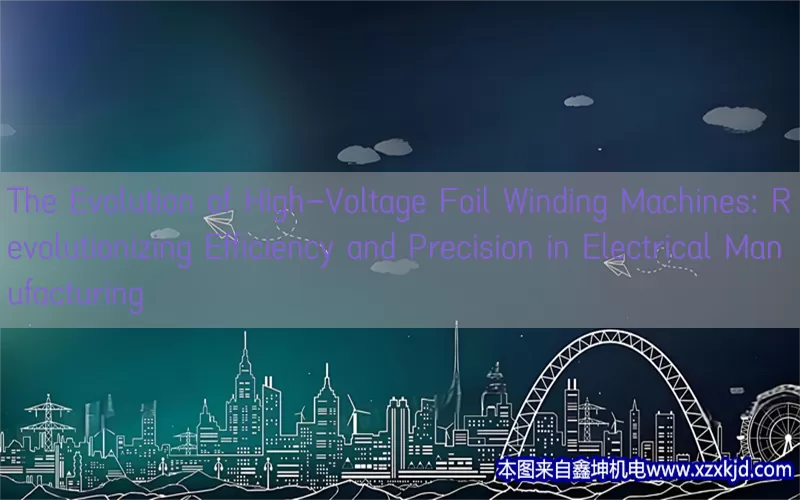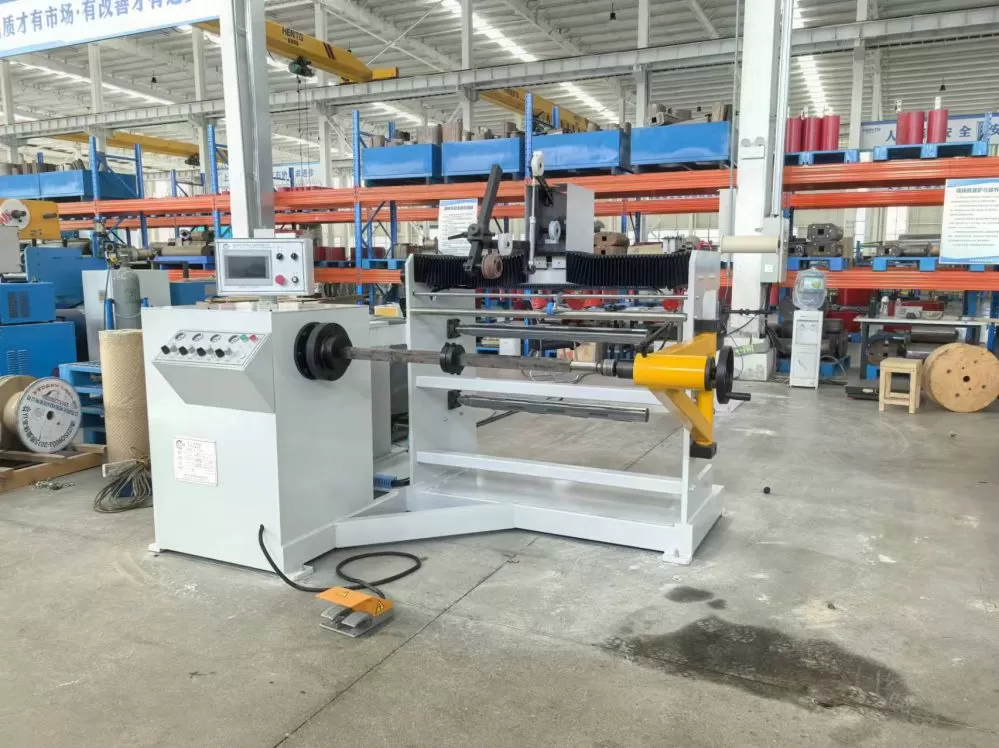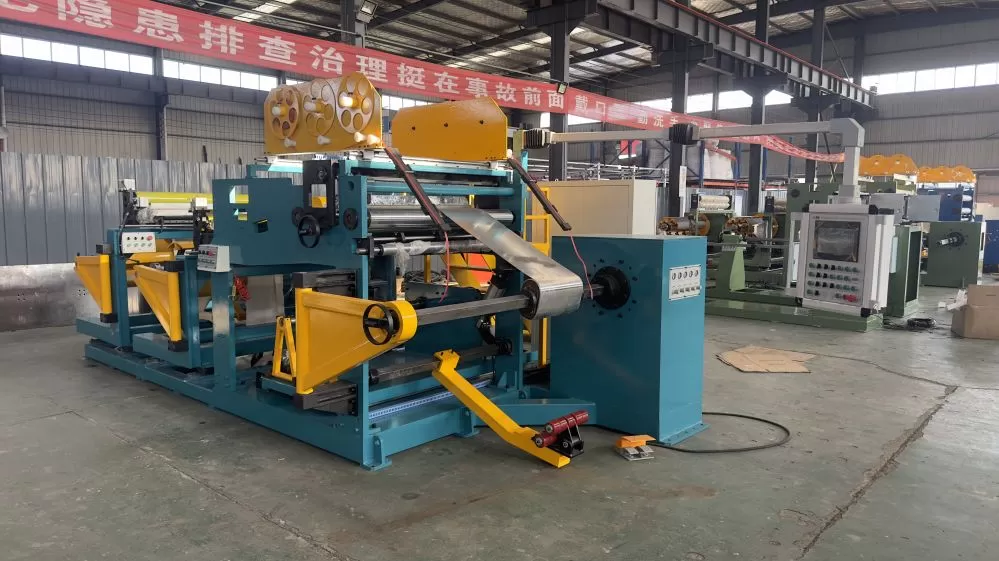The Evolution of High-Voltage Foil Winding Machines: Revolutionizing Efficiency and Precision in Electrical Manufacturing
In the world of electrical manufacturing, precision and efficiency are key factors for success. As the demand for high-performance electrical components continues to rise, manufacturers are seeking innovative solutions to optimize production and ensure quality. One of the most transformative technologies in this space is the high-voltage foil winding machine. Designed specifically to meet the intricate needs of transformer and coil production, these machines are reshaping the industry by delivering unprecedented levels of efficiency, precision, and reliability.

The Role of High-Voltage Foil Winding Machines in Electrical Manufacturing
At its core, a high-voltage foil winding machine is designed to wind conductive foil—typically copper or aluminum—around a core to form electrical coils, which are essential components in transformers, inductors, and other electrical devices. These coils play a critical role in managing the electrical current, ensuring the stability and performance of the entire system. Traditional winding methods often involved labor-intensive processes with significant room for error. In contrast, modern high-voltage foil winding machines automate the process, reducing the risk of human error and ensuring uniformity in the windings.
By utilizing advanced computerized control systems, high-voltage foil winding machines can handle a variety of complex winding patterns, adjust the tension on the foil, and manage other factors such as insulation layering with incredible precision. This level of control leads to better-performing components, with higher resistance to electrical stress and improved heat dissipation. These factors are especially important in high-voltage applications, where even the smallest deviations can lead to catastrophic failures.
Advantages of High-Voltage Foil Winding Machines
One of the most notable advantages of high-voltage foil winding machines is their ability to drastically increase production efficiency. By automating the winding process, manufacturers can produce coils at a much faster rate compared to manual methods. This increase in speed does not come at the expense of quality; in fact, the precision of the machine ensures that every coil is wound to exact specifications, reducing the need for rework and minimizing scrap material.
Additionally, these machines are highly versatile. Whether the production involves small transformers for consumer electronics or large power transformers for industrial applications, high-voltage foil winding machines can be easily adapted to meet different production needs. This flexibility allows manufacturers to streamline their operations, reducing the need for multiple machines to handle different tasks.
The automation capabilities of foil winding machines also offer significant cost savings. Labor costs are reduced as fewer workers are required to operate the machines, and the enhanced precision leads to fewer defects and less waste. Over time, this results in lower production costs and higher profit margins.
Precision and Quality: A Winning Combination
In the electrical manufacturing industry, precision is non-negotiable. High-voltage foil winding machines excel in this regard, thanks to their ability to maintain tight tolerances and produce consistent results. The accuracy of these machines ensures that the electrical components they produce meet stringent industry standards, which is crucial for ensuring the safety and reliability of electrical systems.
Moreover, the advanced features of these machines, such as programmable control systems, allow for real-time monitoring and adjustments during the winding process. This means that operators can make on-the-fly corrections to ensure that the coils are wound perfectly every time. In addition, many high-voltage foil winding machines are equipped with quality control features that automatically inspect the finished product for defects, further enhancing the reliability of the components.
While the speed and precision of high-voltage foil winding machines have garnered significant attention, their ability to handle high-voltage applications is equally important. Electrical components, particularly transformers, must be designed to handle extreme electrical stresses without breaking down. High-voltage foil winding machines contribute to this by creating coils with superior insulation and durability, which are vital for handling the demands of high-voltage systems.
Meeting the Challenges of High-Voltage Applications
In high-voltage environments, electrical components are subjected to significant thermal and electrical stresses. If the winding process is not performed with absolute precision, it can lead to weak points in the coil, which may result in breakdowns, short circuits, or overheating. High-voltage foil winding machines are designed to prevent such issues by ensuring that each layer of foil is perfectly aligned and insulated.
One of the key challenges in high-voltage transformer production is managing the insulation between the layers of foil. Inadequate insulation can result in electrical arcing, which can cause significant damage to both the transformer and the surrounding systems. High-voltage foil winding machines address this issue by incorporating precise insulation layering systems that ensure uniform coverage and reduce the risk of electrical faults.
Furthermore, the tension control mechanisms in these machines are critical for maintaining the integrity of the windings. Uneven tension during the winding process can lead to loose coils, which may cause the transformer to fail under high voltage conditions. With precise tension control, high-voltage foil winding machines eliminate this risk, producing coils that are tight, compact, and able to withstand the rigors of high-voltage operation.
Sustainability and Innovation in the Industry
As the world moves toward more sustainable energy solutions, the role of high-voltage foil winding machines in the production of energy-efficient transformers becomes even more significant. These machines contribute to the development of transformers that minimize energy losses, improving the overall efficiency of electrical grids and reducing the environmental impact of electricity transmission.
In addition to their contributions to energy efficiency, high-voltage foil winding machines are also advancing the use of renewable materials in transformer production. For example, many machines now support the use of recyclable foil materials, which helps manufacturers reduce their carbon footprint. As sustainability becomes a key priority in the electrical manufacturing industry, the innovations brought about by high-voltage foil winding machines are positioning them as essential tools for the future.
The Future of High-Voltage Foil Winding Machines
Looking ahead, the future of high-voltage foil winding machines is full of promise. As demand for more efficient and reliable electrical systems grows, these machines will continue to evolve, incorporating even more advanced technologies such as artificial intelligence (AI) and machine learning. These advancements will enable the machines to self-optimize, further improving production speed, precision, and efficiency.
Moreover, the integration of IoT (Internet of Things) technologies will allow for real-time monitoring and diagnostics, reducing downtime and enhancing the overall productivity of manufacturing plants. As manufacturers continue to push the boundaries of what is possible in electrical manufacturing, high-voltage foil winding machines will undoubtedly play a central role in driving innovation.
In conclusion, high-voltage foil winding machines are revolutionizing the electrical manufacturing industry by delivering unmatched efficiency, precision, and reliability. Whether it's improving transformer performance, reducing production costs, or contributing to sustainability efforts, these machines are setting new standards for excellence. As technology continues to advance, we can expect these machines to play an even more critical role in shaping the future of electrical manufacturing.
提示:在享受本文内容的同时,请注意版权归属 徐州鑫坤机电设备有限公司https://www.xzxkjd.com如果您觉得有价值欢迎分享,但请务必注明出处,感谢您的理解,谢谢!
以下部分内容需要登录查看 立即登录
相关内容
- 供需裂口持续扩大:2025年铜价暴涨,产业链如何应对?
- 铜,新时代的“石油”?2025年价格狂飙背后的战略博弈
- 从能源革命到智能时代:2025铜价暴涨背后的全球新逻辑
- 铜价创历史新高!绿色转型与供需失衡背后的财富浪潮
- 2025铜价为何一飞冲天?三大核心驱动力深度解析
- 上海非急救出租服务全解析
- 深耕中考复读赛道 深圳深才教育为复读生搭建升学桥梁
- 阳光下的童年:那些被温暖照亮的纯真时光
- 群晖DSM7.0-7.21监控套件Surveillance Station 9.20-11289开心版60个许可证设置教程(无重启、无断流、无卡死、史上最完美)
- 云服务器+SD-WAN组网和域名DNS解析
- 在云主机上安装iKuai OS,实现SD-WAN组网,利用云主机80;443端口搭建企业网站。个人博客。让云主机当做你的堡垒机,实现数据本地化。
- 中央空调只开一台=全开耗电?真相让人意外!
 简体中文
简体中文 繁體中文
繁體中文 English
English Nederlands
Nederlands Français
Français Русский язык
Русский язык Polski
Polski 日本語
日本語 ภาษาไทย
ภาษาไทย Deutsch
Deutsch Português
Português español
español Italiano
Italiano 한어
한어 Suomalainen
Suomalainen Gaeilge
Gaeilge dansk
dansk Tiếng Việt
Tiếng Việt Pilipino
Pilipino Ελληνικά
Ελληνικά Maori
Maori tongan
tongan ᐃᓄᒃᑎᑐᑦ
ᐃᓄᒃᑎᑐᑦ ଓଡିଆ
ଓଡିଆ Malagasy
Malagasy Norge
Norge bosanski
bosanski नेपालीName
नेपालीName čeština
čeština فارسی
فارسی हिंदी
हिंदी Kiswahili
Kiswahili ÍslandName
ÍslandName ગુજરાતી
ગુજરાતી Slovenská
Slovenská היברית
היברית ಕನ್ನಡ್Name
ಕನ್ನಡ್Name Magyar
Magyar தாமில்
தாமில் بالعربية
بالعربية বাংলা
বাংলা Azərbaycan
Azərbaycan lifiava
lifiava IndonesiaName
IndonesiaName Lietuva
Lietuva Malti
Malti català
català latviešu
latviešu УкраїнськаName
УкраїнськаName Cymraeg
Cymraeg ກະຣຸນາ
ກະຣຸນາ తెలుగుQFontDatabase
తెలుగుQFontDatabase Română
Română Kreyòl ayisyen
Kreyòl ayisyen Svenska
Svenska հայերեն
հայերեն ဗာရမ်
ဗာရမ် پښتوName
پښتوName Kurdî
Kurdî Türkçe
Türkçe български
български Malay
Malay मराठीName
मराठीName eesti keel
eesti keel മലമാലം
മലമാലം slovenščina
slovenščina اوردو
اوردو አማርኛ
አማርኛ ਪੰਜਾਬੀName
ਪੰਜਾਬੀName albanian
albanian Hrvatski
Hrvatski Suid-Afrikaanse Dutch taal
Suid-Afrikaanse Dutch taal ខ្មែរKCharselect unicode block name
ខ្មែរKCharselect unicode block name




